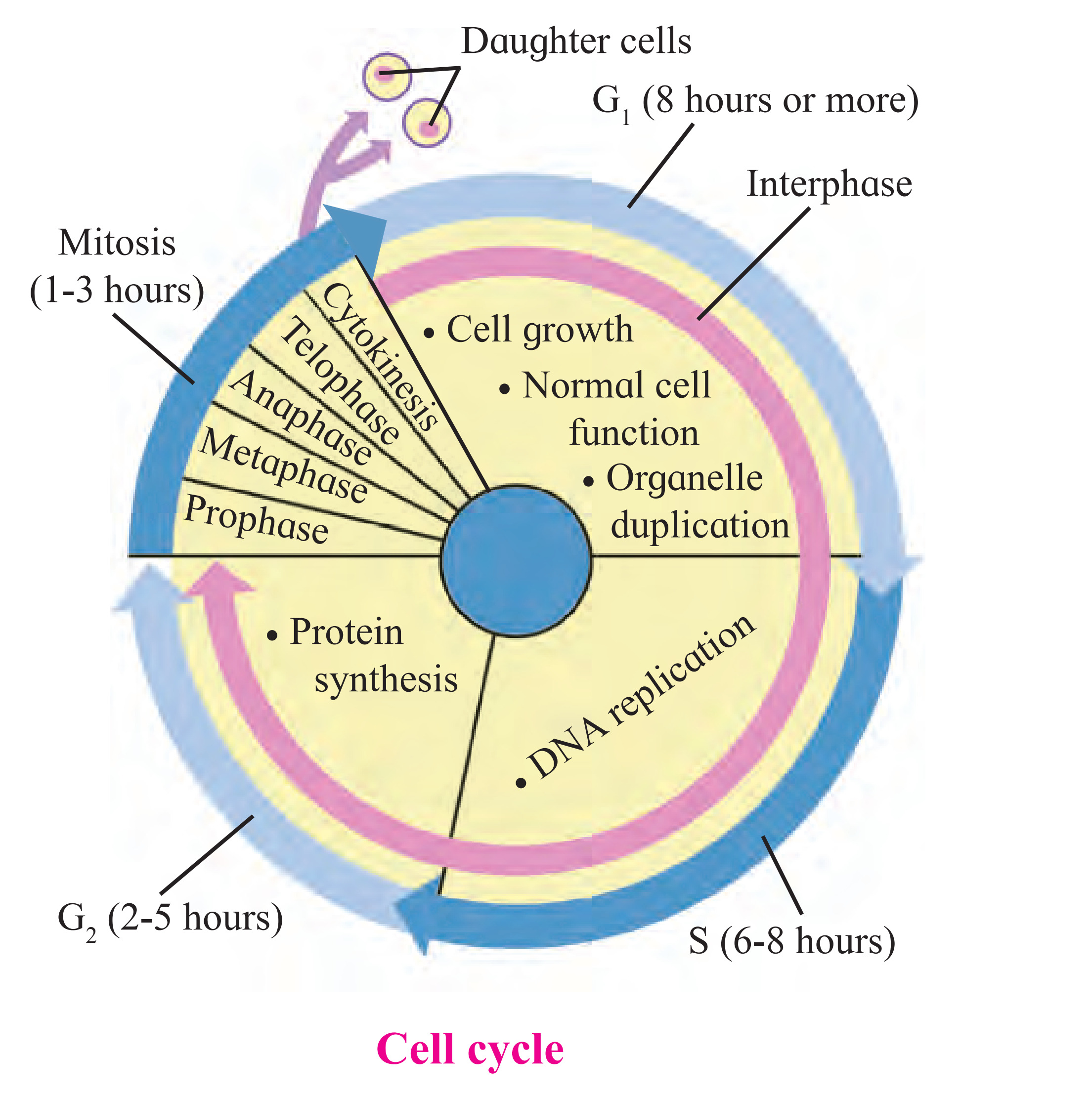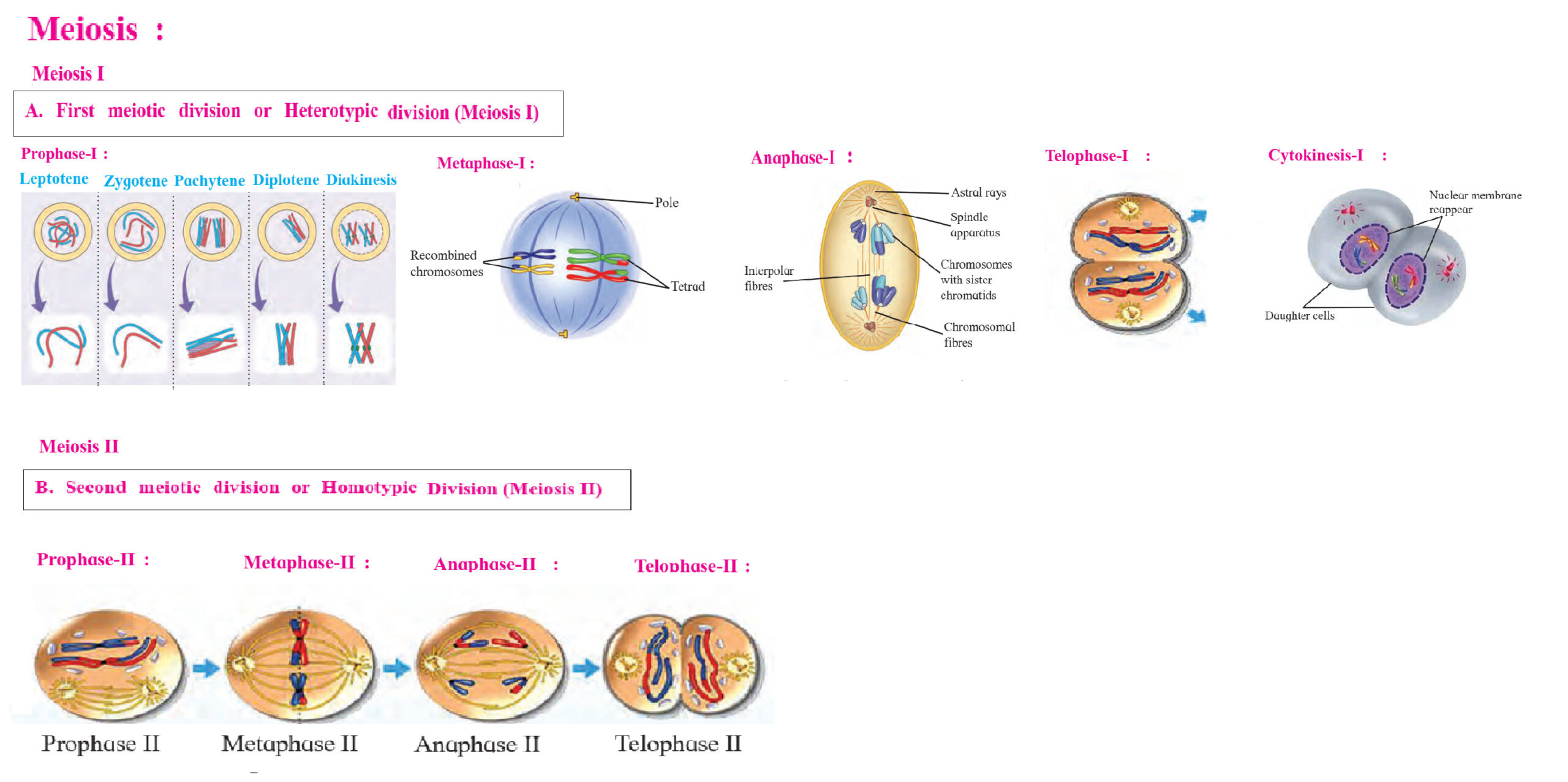(1) Choose correct option
(A) The connecting link between Meiosis-I and Meiosis-II is ……………
(a) interphase-I
(b) interphase-II
(c) interkinesis
(d) anaphase-I
(B) Synapsis is pairing of ………….
(a) any two chromosomes
(b) non-homologous chromosomes
(c) sister chromatids
(d) homologous chromosomes
(C) Spindle apparatus is formed during which stage of mitosis?
(a) Prophase.
(b) Metaphase.
(c) Anaphase.
(d) Telophase.
(D) Chromosome number of a cell is almost doubled up during ……………
(a) G1-phase
(b) S-phase
(c) G2-phase
(d) G0-phase
(E) How many meiotic divisions are necessary for formation of 80 sperms?
(a) 80 (b) 40 (c) 20 (d) 10
(F) How many chromatids are present in anaphase-I of meiosis-I of a diploid cell having 20 chromosomes?
(a) 4 (b) 6 (c) 20 (d) 40
(G) In which of the following phase of mitosis chromosomes are arranged at equatorial plane?
(a) Prophase
(b) Metaphase
(c) Anaphase
(d) Telophase
(H) Find incorrect statement –
(a) Condensation of chromatin material occurs in prophase.
(b) Daughter chromatids are formed in anaphase.
(c) Daughter nuclei are formed at metaphase.
(d) Nuclear membrane reappears in telophase.
(I) Histone proteins are synthesized during ……
a. G1 phase
b. S-phase
c. G2 phase
d. Interphase
(2) Answer the following questions
(A) While observing a slide, student observed many cells with nuclei. But some of the nuclei were bigger as compared to others but their nuclear membrane was not so clear. Teacher inferred it as one of the phase in the cell division. Which phase may be inferred by teacher?
Ans: Prophase.
(B) Students prepared a slide of onion root tip. There were many cells seen under microscope. There was a cell with two groups of chromosomes at opposite ends of the cell. This cell is in which phase of mitosis?
Ans: Anaphase.
(C) Students were shown some slides of cancerous cells. Teacher made a comment as if there would have been a control at one of its cell cycle phase, there wouldn’t have been a condition like this. Which phase the teacher was referring to?
Ans: The phase teacher was referring would be G1 phase.
(D) Some Mendelian hybridization experimental results were shown to the students. Teacher informed that there are two genes located on the same chromosome. He enquired if they will be ever separated from each other?
Ans:
(a) Genes are located on chromosomes at specific distance and position.
(b) The greater this distance, the greater the chance that a crossover can occur between the genes and the greater the chances of recombination.
(c) The chances of recombination are less between the genes that are placed closed to each other on the chromosome.
(d) Therefore, due to recombination the two genes located on the same chromosome have possibility of separating from each other.
(E) Students were observing a film on Paramoecium. It underwent a process of reproduction. Teacher said it is due to cell division. But students objected and said that there was no disappearnce of nuclear membrane and no spindle formation, how can it be cell division? Can you clarify?
Ans :
(a) Paramoecium is a unicellular organism. The division in Paramoecium occurs by amitosis.
(b) It is the simplest mode of cell division.
(c) In amitosis, nucleus elongates and a constriction appears. This constriction deepens and divides the nucleus in two daughter nuclei followed by the division of cytoplasm.
(F) Is the meiosis responsible for evolution? Justify your answer.
Ans:
(a) Meiosis ensures that organisms produced by sexual reproduction contain correct number of chromosomes.
(b) Meiosis exhibits genetic variation by the process of recombination.
(c) Variations increase further after union of gametes during fertilization creating offspring with unique characteristics. Thus, it creates diversity of life and is responsible for evolution.
(G)Why mitosis and meiosis-II are called as homotypic division?
Ans :
(a) In mitosis, the chromosome number and genetic material of daughter cells remain same as that of the parent cell.
(b) In meiosis – II, two haploid cells formed during first meiotic division divide further into four haploid cells. This division is identical to mitosis. The daughter cells formed in second meiotic division are similar to their parent cells with respect to the chromosome number formed in meiosis – I. Hence mitosis and meiosis – II are called homotypic division.
(H) Write the significance of mitosis.
Ans:
(a) As mitosis is equational division, the chromosome number is maintained constant.
(b) It ensures equal distribution of the nuclear and the cytoplasmic content between the daughter cells, both quantitatively and qualitatively. Therefore, the process of mitosis also maintains the nucleo-cytoplasmic ratio.
(c) The DNA is also equally distributed.
(d) It helps in growth and development of organisms.
(e) Old and worn-out cells are replaced through mitosis.
(f) It helps in the asexual reproduction of organisms and vegetative propagation in plants.
(I) Enlist the different stages of prophase-I
Ans : It is the most complicated and longest phase of meiotic division. It is further divided into five sub-phases viz. leptotene, zygotene, pachytene, diplotene and diakinesis.
(a) Leptotene: The volume of the nucleus increases. The chromosomes become long distinct and coiled. They orient themselves in a specific form known as bouquet stage. This is characterized with the ends of chromosomes converged towards the side of nucleus where the centrosome lies The centriole duplicates into two and migrates to opposite poles.
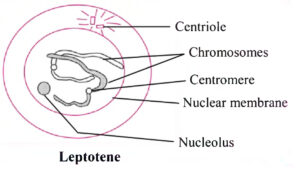
(b) Zygotene: Pairing of non-sister chromatids of homologous chromosomes takes place by formation of synaptonemal complex. This pairing is called synapsis. Each pair consists of a maternal chromosome and a paternal chromosome. Chromosomal pairs are called bivalents or tetrads.
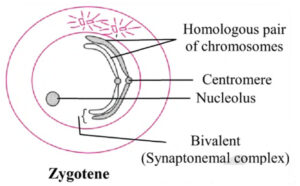
(c) Pachytene:
Each individual chromosome begins to split longitudinally into two similar chromatids. Therefore, each bivalent now appears as a tetrad consisting of four chromatids. The homologous chromosomes begin to separate but they do not separate completely and remain attached to one or more points. These points are called chiasmata (Appear like a cross-X). Chromatids break at these points and broken segments are exchanged between non-sister chromatids of homologous chromosomes resulting in recombination.
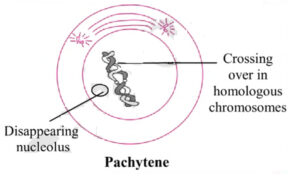
(d) Diplotene: The chiasma becomes clearly visible in diplotene due to beginning of repulsion between synapsed homologous chromosomes. This is known as desynapsis. Synaptonemal complex also starts to disappear.
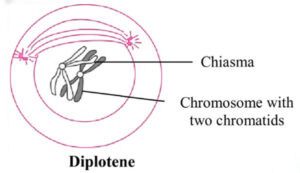
(e) Diakinesis: The chiasmata begin to move along the length of chromosomes from the centromere towards the ends of chromosomes. The displacement of chiasmata is termed as
terminalization. The terminal chiasmata exist till the metaphase. The nucleolus and nuclear membrane completely disappear and spindle fibres begin to appear.
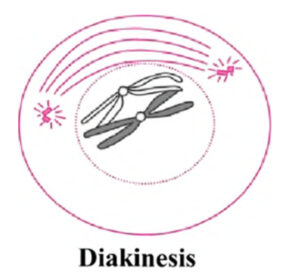
(3) Draw labelled digrams and write explanation
(A) With the help of suitable diagram, describe the cell cycle.
Ans:
(i) Series of events occurring in the life of a cell is called cell cycle. Interphase and M – phase are the two phases of cell cycle.
(ii) Interphase: It is the stage between two successive cell divisions. It is the longest phase of a cell cycle during which the cell is highly active and prepares itself for cell division.
The interphase is subdivided into three sub-phases as G1-phase, S-phase and G2-phase.
(a) G1 – phase (First gap period/First Gap Phase): It begins immediately after cell division. RNA (mRNA, rRNA and tRNA) synthesis, protein synthesis and synthesis of membranes take place during this phase.
(b) S – phase (Synthesis phase): In this phase DNA is synthesized (replicated), so that amount of DNA per cell doubles. Synthesis of histone proteins takes place in this phase.
(c) G2- phase (Second growth phase/Second Gap Phase): Metabolic activities essential for cell division occur during this phase. Various proteins which are necessary for the cell division are also synthesized in this phase. Apart from this, RNA synthesis also occurs during this phase. In animal cells, a daughter pair of centrioles appears near the pre-existing pair.
(B) Distinguish between mitosis and meiosis.
Ans :
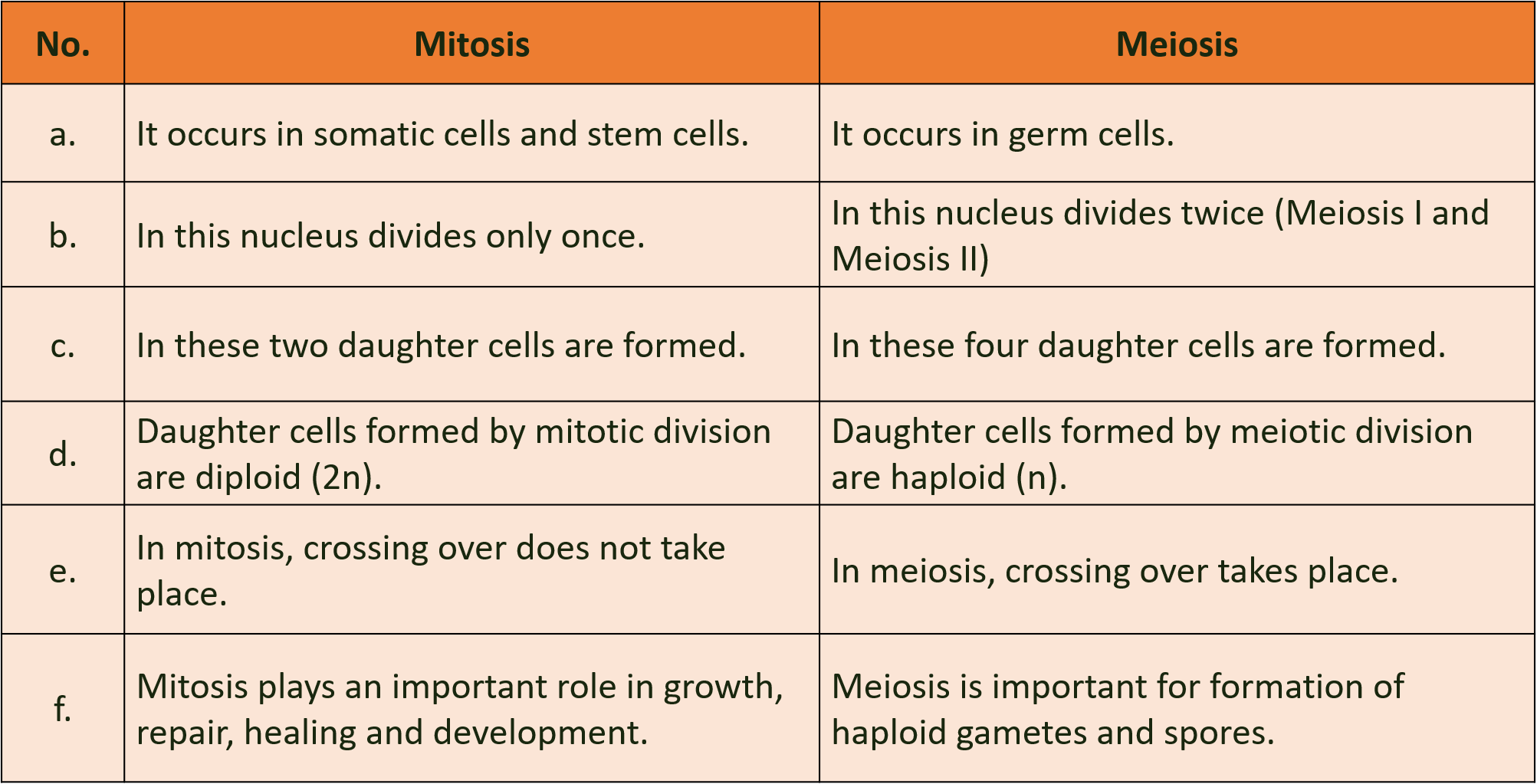
(C) Draw the diagram of metaphase. ![]()
Ans :
(a) Chromosomes are completely condensed and appear short.
(b) Centromere and sister chromatids become very prominent.
(c) All the chromosomes are arranged at equatorial plane of cell. This is called metaphase plate.
(d) Mitotic spindle is fully formed in this phase.
(e) Centromere of each chromosome divides horizontally into two, each being associated with a chromatid.
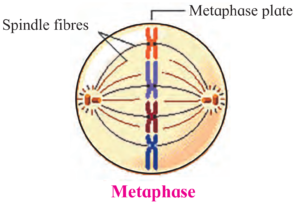
(4) Match the following column-A with column-B
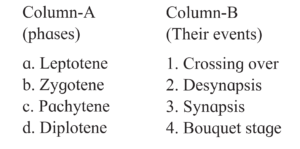
Ans : (a-1), (b-2), (c-3), (d-4)
(5) Is a given figure correct? why?

Ans:
(a) The given figure is incorrect as the spindle fibres are not attached to centromere of the chromosomes.
(b) During metaphase, chromosomes are attached to spindle fibres with the help of centromeres.
![]() (6) If an onion has 16 chromosomes in its leaf cell, how many chromosomes will be there in its root cell and pollen grain.
(6) If an onion has 16 chromosomes in its leaf cell, how many chromosomes will be there in its root cell and pollen grain.
Ans:
(a) The chromosomes in root cell will be 16 as root cell is a diploid cell.
(b) The chromosomes in pollen grain will be 8 as pollen grain is a haploid cell.
( 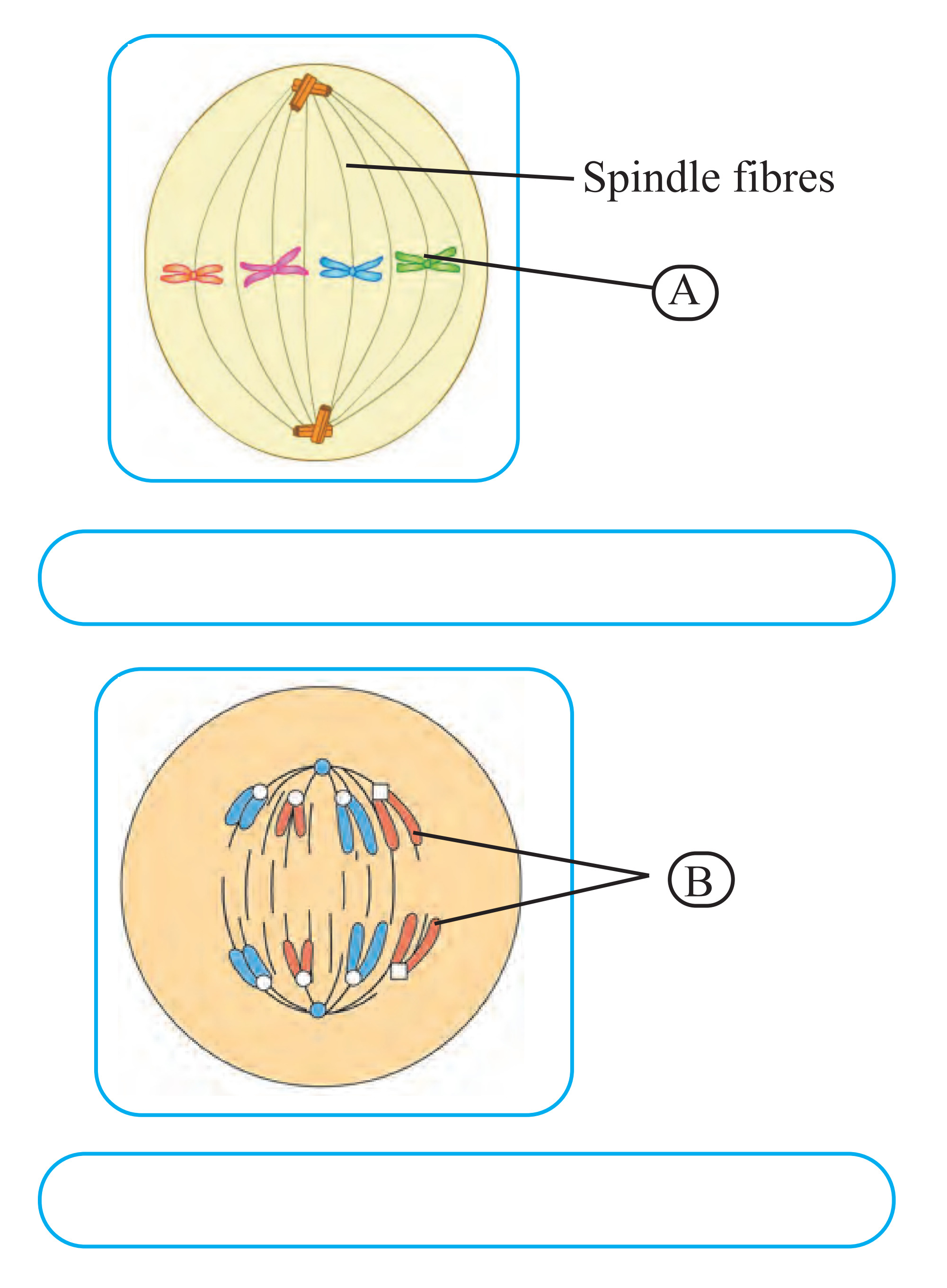 7) Identify the following phases of mitosis and label the ‘A’ and ‘B’ given in diagrams.
7) Identify the following phases of mitosis and label the ‘A’ and ‘B’ given in diagrams.

![]()
Ans: The diagram shown is of Mctaphase.
A: Chromosomes arranged on metaphase plate

Ans: The diagram shown is of Anaphase.
B: Chromatids moving to opposite poles.
